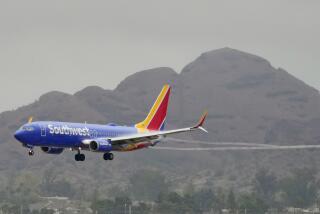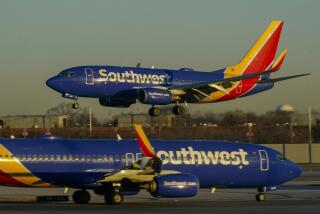A Sky Full of Imitators : CUT-RATE PIONEER : ‘Southwest’ Still Mantra Among Frustrated Rivals
- Share via
USAir executives refer to their new strategy by the code name “Project High Ground.” Continental Airline’s version is called “Calite.” United Airlines dubbed its “U-2.”
The names and methods may vary, but the objective of all these airlines is more or less the same: Beat industry darling Southwest Airlines at its own low-cost, low-fare game.
The number of potential challengers has grown large enough to worry Wall Street--where Dallas-based Southwest’s once-high-flying stock has languished recently--and to spur the airline to defend its franchise from Southwest wanna-bes. Just last week, United said it would aim U-2 directly at Southwest’s West Coast franchise, launching the new low-fare carrier Oct. 1, if shareholders approve an employee takeover of UAL in a vote next month.
But most industry observers remain skeptical about the long-term prospects for cloning Southwest.
“People have been trying for 22 years to come up with something that will stop Southwest,” said Robert J. McAdoo, an airline industry analyst at Prudential Securities. “But nothing seems to stop Southwest.”
Some airlines have pretty much given up trying. American Airlines, for example, has abandoned many routes in California because it cannot match Southwest fares and still turn a profit. Instead, it found a proxy in low-cost newcomer Reno Air, which has taken over American routes and offers passengers American frequent-flier miles.
Still, the industry remains fixated on Southwest. And who wouldn’t be interested in an airline that enjoys some of the lowest operating costs in its class--and generated profits during the early 1990s while competitors were piling up billions of dollars in losses. Last year, Southwest posted a profit of $154 million on $2.3 billion in revenue.
Since Southwest began flying 22 years ago, the company has been fanatical about maintaining low operating costs by keeping things simple. It serves passengers only snacks and beverages and operates primarily on short-haul routes of 500 miles or less. While most carriers’ airplanes sit at the gate for nearly an hour between flights, most Southwest jets are taxiing back out to the runway in 20 minutes or less.
As Southwest has expanded across the country--it now flies to more than 40 cities--and cut fares in its wake, even the industry’s giants have been forced to come to grips with the fast-growing airline and passengers’ bottomless appetite for low prices.
Last year, Continental began chopping fares and increasing frequency on short-haul routes with its Calite flights. USAir wants to match Southwest’s speed in unloading and loading passengers and getting planes back in the air. And United is talking about building U-2 to 143 flights daily by December mimicking Southwest’s long flight days and quick turnaround with a fleet of 737s.
Rival airline executives have also tried to emulate Southwest’s flexible union work rules, which give it some of the industry’s most productive employees. Alaska Airlines and its flight attendants resolved a longstanding labor dispute by adopting an exact copy of Southwest’s union contract.
“Right now, there is a din out there: ‘Southwest, Southwest, Southwest,’ ” said Michael Boyd, president of Aviation Systems Research, a consulting firm in Boulder, Colo.
But the spotlight might be getting too hot for Southwest and its chairman, Herbert D. Kelleher. Southwest shares, which traded as high as $36 in March, have fallen about 30% in value as investors worry about the growing competitive pressures on the carrier. The stock closed Friday at $26, down $1.
While Southwest remains adamant that it will not lose ground, Kelleher and crew are taking no chances. In December, Southwest acquired Salt Lake City-based Morris Air for $134 million--partly as a way to expand more quickly in the face of new competition.
“It gives us extra reason to be extra wary,” Kelleher said. He sounds confident nonetheless: “We have the strongest balance sheet in the industry. We have the wherewithal to fight any battles that might take place.”
Kelleher said he understands the major airlines’ efforts to control--and lower--costs to remain competitive in a highly unstable industry. But he warned that Southwest will retaliate against any direct threats by launching low-cost, long-distance service, invading the domain now dominated by larger carriers such as United, American and Delta.
“The options available to us are not solely defensive in nature,” he said, noting that a few Southwest routes already exceed 1,000 miles.
Kelleher also points out that previous attempts to compete head-on with Southwest have failed--or been quietly dropped.
In 1981, for example, United said it would launch a no-frills, low-fare airline to challenge the likes of Southwest. But United’s passengers got the low-frills service confused with the carrier’s standard full service.
“There was a perception problem,” United spokesman Joe Hopkins said. “So we backed off of it after a time.”
Many industry analysts believe the current round of Southwest imitators will also fade as the economy continues to improve and the major airlines once again generate profits.
Says Colorado consultant Boyd: “I think that the minute the Americans and Uniteds make a decent quarterly profit, they will think everything is fine . . . and they will go right back to business as usual.”
* BOEING’S WORKHORSE: The 737 is the jet of choice for budget carriers. D4
Flying Low
Why is Southwest Airlines thriving while other carriers struggle to imitate its success? Largely because Southwest has among the lowest operating costs in the industry. Airlines measure efficiency in terms of the cost of flying one seat one mile--the so-called cost per available seat mile, or ASM. By that standard, Southwest’s costs are the second-lowest among major U.S. carriers. ASM costs for the fourth quarter of 1993, in cents:
America West: 6.97 cents
Southwest: 7.14 cents
Continental: 8.27 cents
American: 9.05 cents
Northwest: 9.24 cents
United: 9.29 cents
Delta: 9.72 cents
TWA: 10.14 cents
USAir: 11.69 cents
Source: Avitas
More to Read
Inside the business of entertainment
The Wide Shot brings you news, analysis and insights on everything from streaming wars to production — and what it all means for the future.
You may occasionally receive promotional content from the Los Angeles Times.










